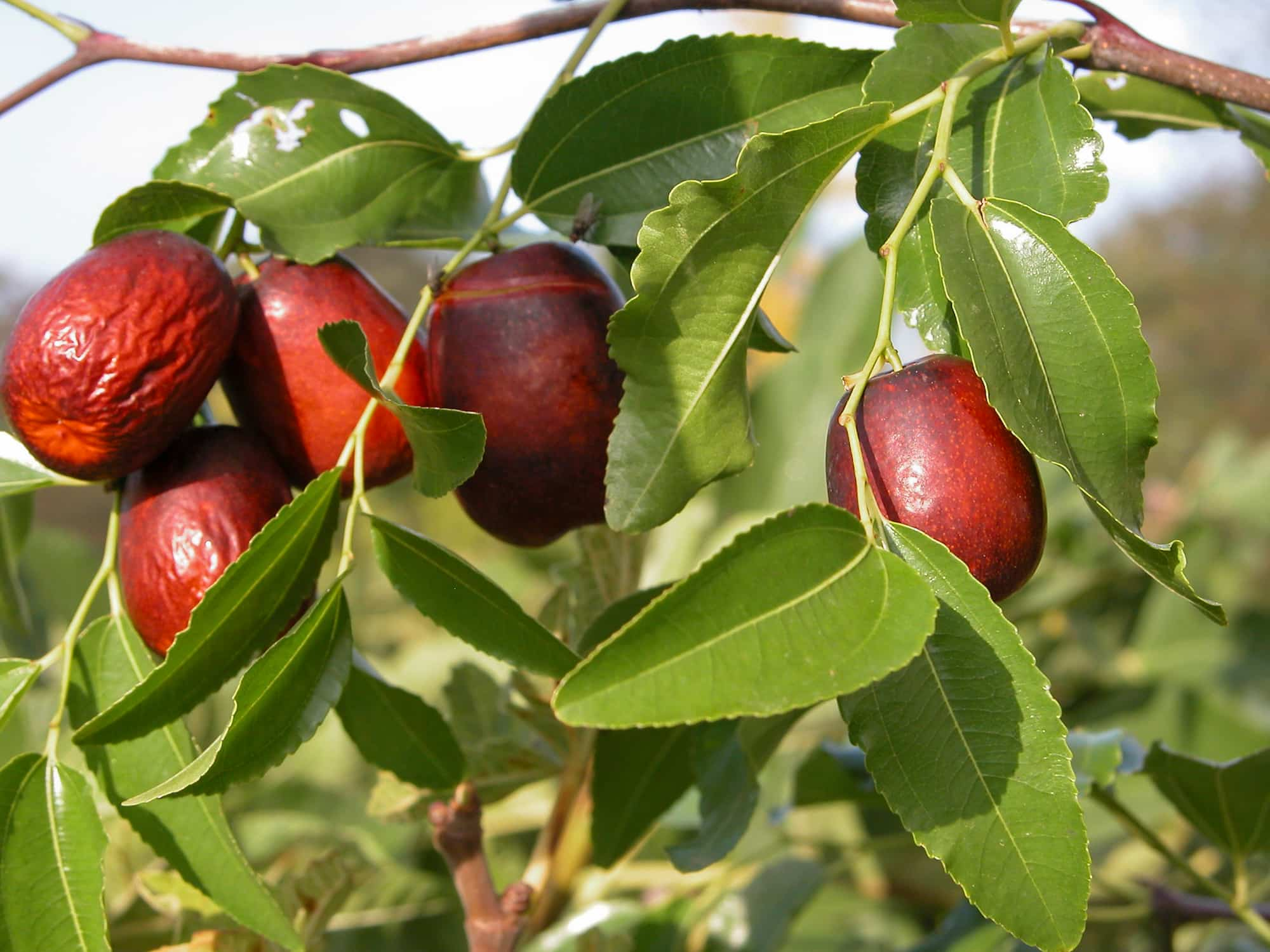
Jujube tree: planting, pruning, and care
Contents
Jujube in a nutshell
- This bush native to China produces small fleshy edible fruits known as jujubes.
- Hardy down to -15°C, it is particularly suited for cultivation in Mediterranean regions where it was very common around fifty years ago.
- With its twisted habit and glossy foliage, the jujube tree is a beautiful ornamental tree.
- It thrives in dry, poor, well-drained soils and tolerates sea spray.
- Its discreet flowering is highly fragrant and nectariferous.
A word from our expert
Originating from China, jujube (Ziziphus jujuba) has spread widely across the globe and now grows from Southern Europe to the Southwestern United States, including the Middle and Near East, India, Northern China, and Japan. Due to its drought resistance and tolerance of salty winds, as well as its ability to thrive in dry, calcareous soils, it is particularly well-suited for cultivation in the south of France. Hardy down to -15°C, it can grow in other regions, but fruiting will be more challenging. When the heat is present, the jujube produces oval fruits, varying in size depending on the variety, known as jujubes or Chinese dates, in September and October.
With its attractive, slightly twisted, trailing habit, the jujube makes an ornamental tree that fits well in a decorative garden or an orchard alongside olive or almond trees. More or less spiny, the jujube can also be planted in a live or defensive hedge, especially as it is particularly suckering. In summer, discreet greenish flowers, which are especially melliferous, emerge in the axils of the leaves.
Botany
Botanical data
- Latin name Ziziphus jujuba
- Family Rhamnaceae
- Common name Chinese date palm, Red date
- Flowering summer
- Height 6 to 10 m
- Exposure full sun
- Soil type dry, calcareous, poor, stony
- Hardiness down to -15°
Ziziphus jujuba belongs to the Rhamnaceae family, a family of flowering plants that produce berries, fleshy drupes, or nuts. The Rhamnaceae family also includes trees or bushes with stipulate leaves. Among the most well-known species in this family are the jujube tree, as well as the Ceanothus (California lilac) and Rhamnus (buckthorn and blackthorn).
Cultivated in East Asia, India, and China for over 4000 years, the common jujube is believed to have been introduced to southern Europe from Syria via Italy by Emperor Augustus. It is still widely cultivated in central and northern Italy, as well as in Algeria and Morocco. In Algeria, Annaba, the ancient Hippo, one of the main cities of Roman Africa, means “city of jujube trees.” And in the Moroccan Atlas, a delicious honey made from jujubes is still produced. Just fifty years ago, many small gardens in southern France had their own jujube tree, known as chirchoulier (or circoulier) in the Midi.
Ziziphus jujuba derives its name from the Arabic “zizouf.” The genus Ziziphus includes about ten species and over 400 cultivars, developed in China and the United States.
The jujube tree is a small fruit tree that has fallen out of favour in recent years but deserves to be reintroduced into our gardens due to its many advantages. Hardy down to -15°, and even more for some varieties, it can be grown almost anywhere in France. However, it is in southern France, in Provence, that it will bear fruit, as it requires a long period of heat to produce its drupes. Elsewhere, the common jujube will be used as an ornamental bush, either as a standalone in a garden or in a defensive or informal hedge. The jujube tree indeed has many attractive features.
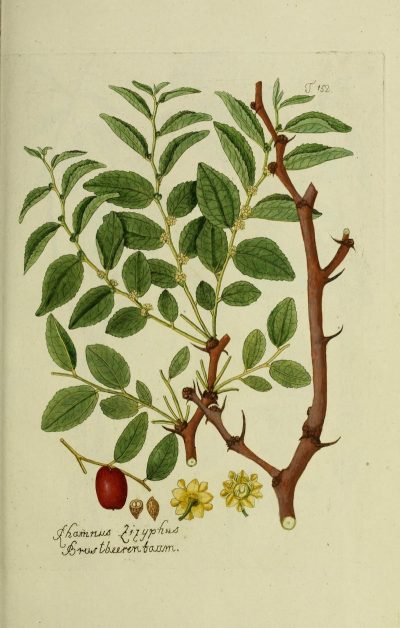
Botanical illustration of Ziziphus
Its rounded habit gives it a lovely silhouette. With a tortuous, zigzagging, and slightly pendulous branching structure, the jujube tree is a perennial bush with deciduous, leathery foliage, a beautiful dark green, glossy. Finely dentate, the alternate, ovate, and lanceolate leaves are equipped with spiny stipules, located on either side of the petiole. However, some other varieties will be inermous. This characteristic makes the jujube tree a bush perfectly suited for planting in a defensive hedge.
In older specimens, the bark becomes a beautiful pinkish beige, cracking and covered with scales. Slow-growing, the jujube tree has a deep and extensive root system. It is also very suckering and can produce many shoots far from the parent plant. It can reach a height of 6 to 8 metres and a width of 3 to 4 metres.
The flowering is practically insignificant visually but has olfactory interest. In May and June, for about fifteen days, the jujube tree produces clusters of 2 to 5 small flowers, greenish to whitish, that blend in with the foliage. Measuring 3 to 4 mm long, consisting of 5 sepals, 8 stamens, and 5 petals, these hermaphrodite flowers appear discreetly in the axils of the leaves. However, their fragrance is remarkable, and the flowers are extremely nectariferous and melliferous, attracting many insects, particularly bees.
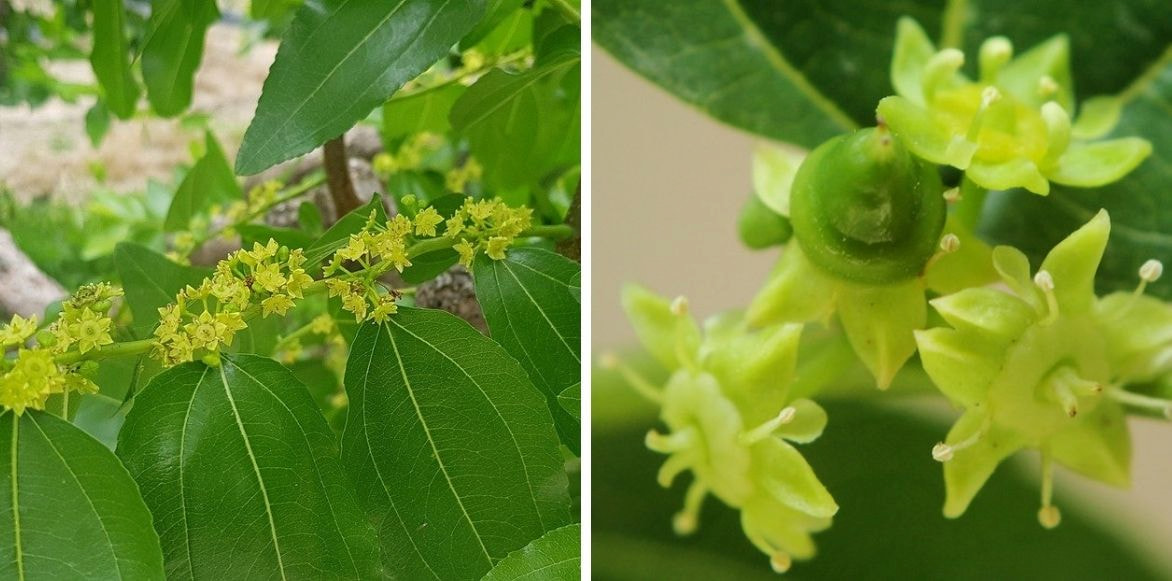
The flowers of the jujube tree are highly fragrant and nectariferous
In the Midi, the jujube tree is primarily cultivated for its fruits, the jujubes, also known as Chinese dates or chichourles. Oval in shape, these fleshy drupes ripen between September and October. Edible, the fruits have a more or less large stone, valued for its cosmetic properties, and a firm, gelatinous or floury pulp, with a slightly tangy and sweet flavour. When the fruit is overripe, it takes on the texture of a date. Depending on the varieties, the size of the fruits ranges from that of an olive to that of an apple. Initially yellow or green, the drupes turn reddish-brown to coppery brown when ripe.

Depending on the varieties of Ziziphus, the jujubes vary from the size of an olive to that of an apple. Their colours range from reddish-brown to yellow
The jujube tree only produces from its fourth year and, over time, its fruiting becomes exponential, provided it enjoys sufficiently high temperatures for a long duration. The jujube tree belongs to the category of small trees resistant to drought, sea spray, and coastal soils.
The main varieties
Ziziphus jujuba includes several cultivated varieties found around the world. Some cultivars have been particularly developed in the south of France, others in Asia, and still others in the United States.
In the south of France, traditional varieties known as Ziziphus jujuba de Provence were cultivated. These jujube trees produce large, oblong fruits that are yellow or red when ripe, particularly sweet, and can be consumed dried. They have abundant but irregular fruiting. The branches are thorny.
Among the cultivars distributed by the United States, Ziziphus jujuba ‘Sherwood’ features large late fruits and is a low-thorn bush with a columnar habit. Ziziphus jujuba ‘Honey Jar’ produces smaller, very sweet fruits.
Other cultivars have been developed in China, including Ziziphus jujuba ‘Lang’, which has very large pear-shaped fruits. Practically inermous, it has a quick fruiting period, within one to two years. Ziziphus jujuba ‘So’ is very decorative with its compact habit and offers round fruits of good size. It is ideal for small spaces. Our favourite is Ziziphus jujuba ‘Li’.
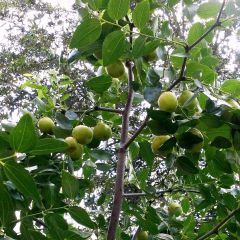
Ziziphus jujuba Li
- Période de floraison July, August
- Hauteur 6,50 m
You may also encounter other species of Ziziphus: Ziziphus lotus is very drought-resistant, while Ziziphus mauritiana (Iguana Jujube) produces round, reddish-brown to yellow fruits with sweet flesh.
Planting the jujube tree
Where to plant jujube?
The jujube tree should be planted in full sun, sheltered from drafts, which it particularly dislikes. However, avoid planting it too close to a building, as its root system spreads widely. In the south of France, it can tolerate a semi-shaded position to some extent.
The jujube tree is quite drought-resistant and tolerates sea spray.
As for the soil, the jujube tree has few requirements since it can thrive in arid, dry, and rocky soils. It prefers neutral or calcareous soils, but especially light ones. Excellent drainage is essential; heavy, damp soil will be fatal for it. Although it thrives in poor soil, the jujube tree does not mind fertile soil that aids in its fruiting. Accommodating, it also prospers in saline soil.
When to plant a jujube tree?
Generally, the jujube tree is planted in spring, in March or April. However, in the Mediterranean region, autumn planting can be carried out.
How to plant the jujube tree?
- Dig a hole 40 cm deep and wide. If you wish to plant jujube trees within a hedge, space them at least 80 cm apart.
- Add some sand if your soil is too heavy.
- Add well-matured compost or potting soil to give your bush a boost.
- Backfill the hole and firm it down.
- Water generously.
Care
Once well established, the jujube tree requires little care. However, in the first and second years after planting, it should be watered generously once or twice a week, especially in summer. After that, two waterings per month are sufficient from the third year onwards. Applying mulch will help retain some moisture.
Once a year, a supply of fertiliser or compost rich in nitrogen should be added to facilitate fruiting.
In the early years, it is also recommended to cover it with a winter fleece if temperatures are too cool.
Pruning the jujube tree
If pruning is not obligatory, it can still be carried out every 3 years to remove dead branches and eliminate poorly oriented central shoots. This pruning aims to give the jujube tree a nice habit while also making the harvest of jujubes easier. This light pruning can also be done annually, at the end of winter, in March. In any case, take precautions by equipping yourself with gloves and long sleeves, as the jujube tree is thorny!
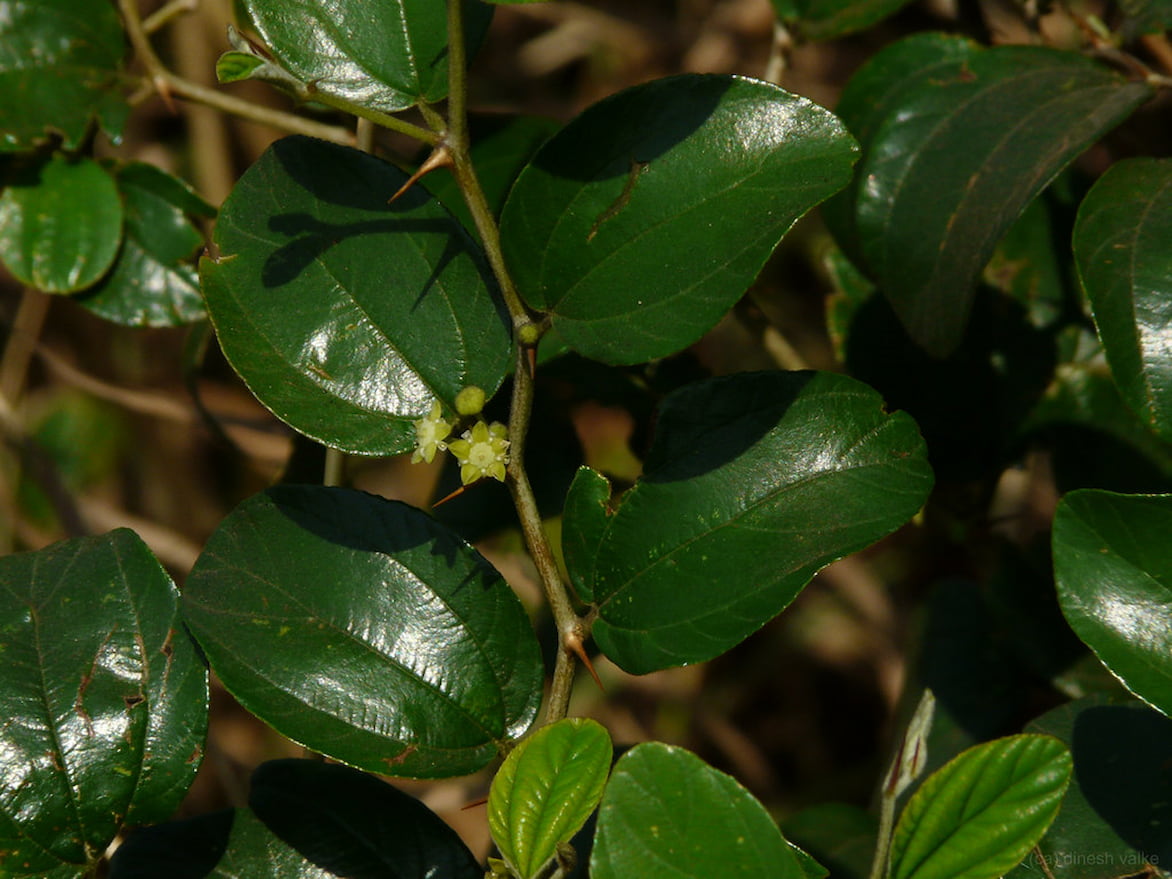
Pruning can be carried out every 3 years
If you wish to train your jujube tree as a low-stem, cut the leading shoot and keep 3 to 4 main branches.
Diseases and pests
The only true enemy of the jujube tree is the Mediterranean fly, often found in orchards in the south of France. Ceratitis capitata, as it is commonly known, lays its eggs under the skin of jujubes when they reach ripeness.
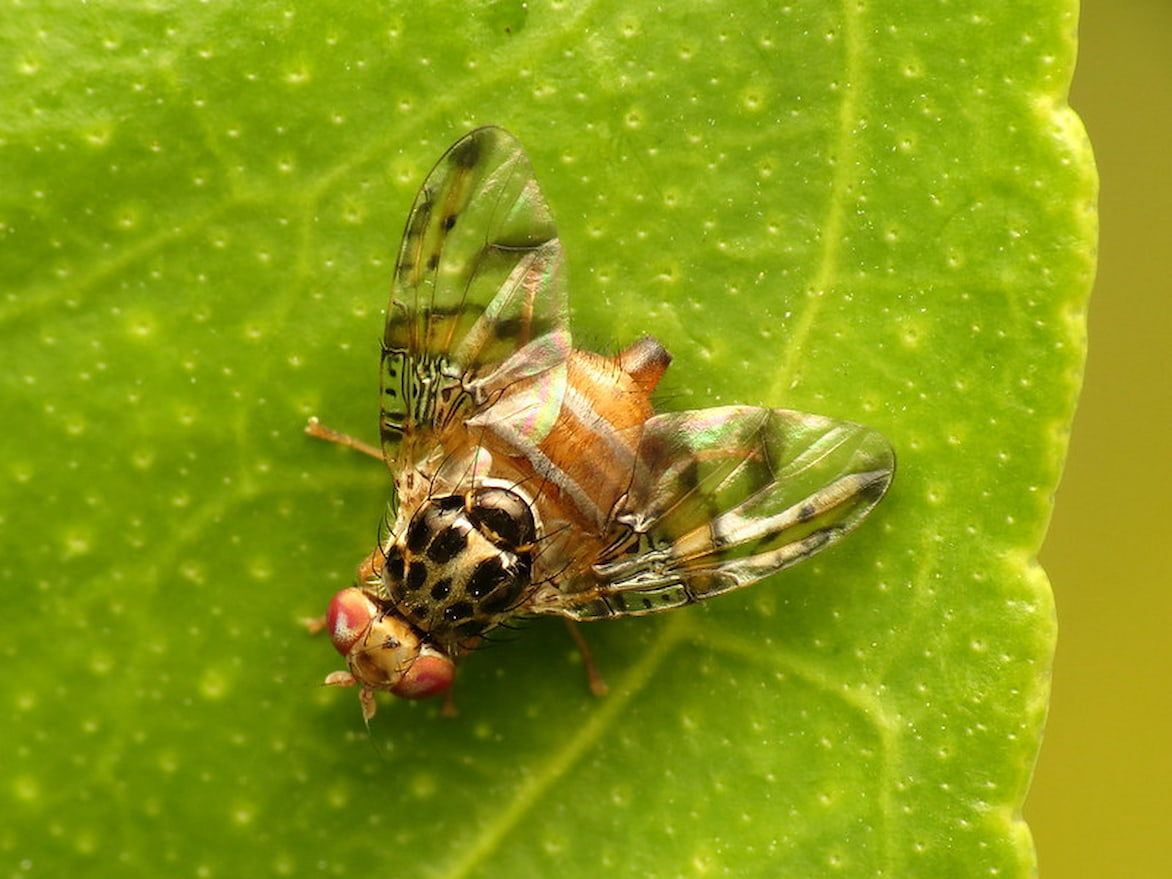
The Mediterranean fly is the main enemy of the jujube tree
Generally, fruits that are punctured or marked with galleries are signs of Mediterranean fly attacks. In this case, it is essential to act quickly by removing the damaged fruits. However, the most effective approach remains prevention using natural methods. In spring, set up pheromone traps in your jujube tree or use yellow sticky chromatic strips to trap adult flies.
How to propagate the jujube tree?
The propagation of the jujube tree is relatively accessible but lengthy. It can be done by sowing, propagation by cuttings, or division of suckers. However, avoid taking an ungrafted jujube tree from the wild, as it easily self-seeds and may become invasive. Additionally, it can produce countless shoots.
Propagation by sowing
At the time of fruit harvest, collect seeds and carefully remove the surrounding flesh. Before planting, it is necessary to scarify: keep the stone warm for 3 months, then for another three months in continuously moist sand. Thus, when spring arrives, the stone can be sown in a mixture of sand and potting soil and kept in a cold frame. To facilitate germination, you can crack the stone. Germination is unpredictable; it may occur quickly a few weeks after sowing or the following spring!
Once the jujube seedlings have developed, transplant them into pots and keep them in a cold frame over winter.
Propagation by cuttings
For the jujube tree, cuttings are taken from one-year-old woody stems in autumn.
- Take a cutting of about 15 cm, cutting below the buds and removing the lower leaves to leave only two or three upper leaves.
- Plant in a mixture of potting soil and sand.
- Keep in a cold frame over winter.
- Transplant in spring into the open ground.
Propagation by division of suckers
This division of suckers is done in autumn or winter. The suckers taken should be at least one year old to have a sufficiently developed root system.
Start by digging between the parent plant and the sucker, then, using a spade or pruning shear, cut the root cleanly. The shoot can be planted in its final location if it is vigorous enough. Otherwise, transplant it into a pot and plant it in the ground the following spring. Water thoroughly after planting.
What to pair with the jujube tree?
With its twisted habit and profusion of colourful fruits, the jujube tree makes a stunning addition to an ornamental garden, whether alone or in combination with other bushes or trees such as the pomegranate, the Japanese medlar, the fig tree, or even an olive tree. In an orchard, it thrives alongside almond trees or peach trees.
As it is a bush equipped with thorns, the jujube tree can be planted within a defensive hedge. In this case, harvesting the fruits may be challenging, so it can be established in less favourable regions, sheltered from drafts. For a truly deterrent hedge, you can combine it with a Pyracantha (Firethorn), a Berberis thunbergii (Japanese barberry), a Mahonia aquifolium, a Poncirus trifoliata, an Ilex (holly), or a hawthorn. All these bushes serve to enclose a space while providing cover for garden birds.

Berberis thunbergii, Pyracantha Gold Charmer, Mahonia aquifolium Apollo, Poncirus trifoliata
The harvest of jujubes
The drupes of the jujube tree reach ripeness in September or October, depending on the precocity of the varieties. They can be consumed at just the right ripeness or dried, which can alter the flavour and colour. The jujube, or chichourle in the south, has a slight apple taste when young and tends towards a date flavour when consumed dried.
Beyond its taste, the jujube is packed with multiple benefits: it is rich in vitamins A, B, B1, B2, B6, and especially C (20 times more than an orange!), which gives it antioxidant properties. And it is lower in calories than a date. The jujube is also well-supplied with minerals such as iron, calcium, phosphorus, and is a source of dietary fibre, useful for stimulating digestion.
Jujubes can be enjoyed fresh or previously dried on racks, like a date.
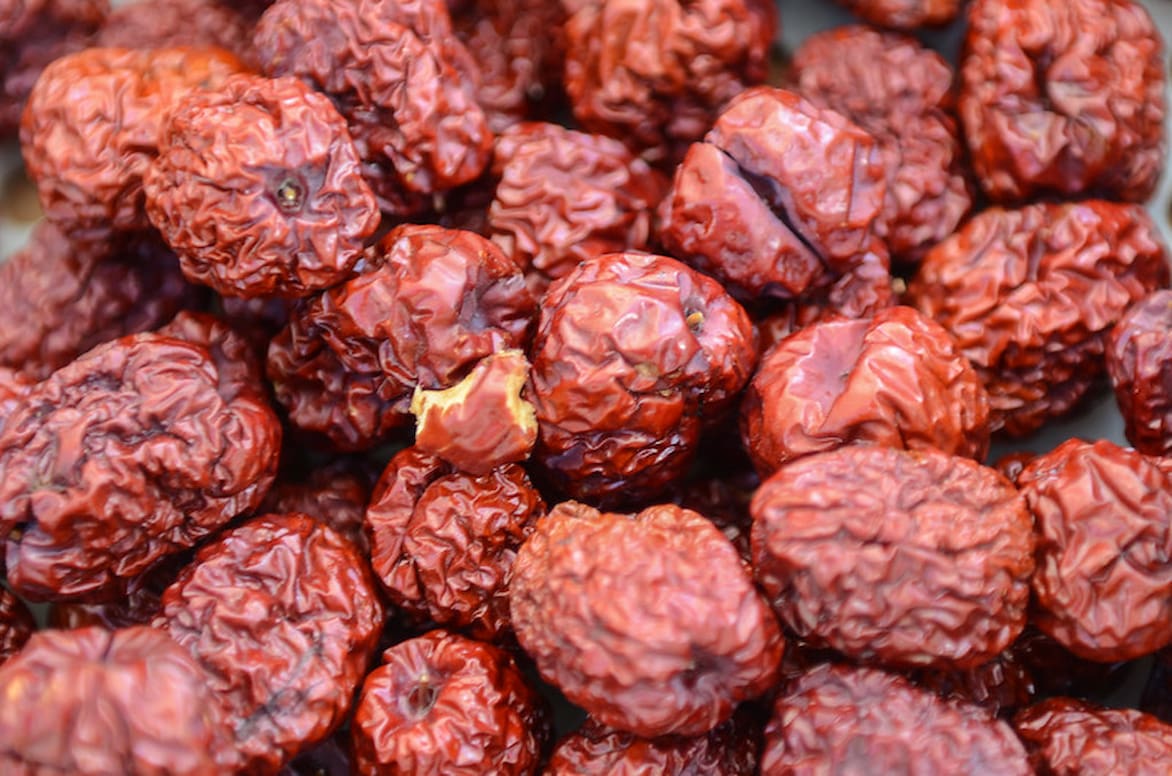
Jujubes can be consumed fresh or dried
They can also be transformed into jams, compotes, jellies, fruit pastes, or candied fruits, preserved in jars with syrup, or used in liqueurs. The jujube is also used in infusions.
Did you know?
Sidr honey, or jujube honey, is often referred to as the best honey in the world. Frequently produced in Yemen, Pakistan, Madagascar, or Morocco, it boasts an exceptional flavour while possessing high nutritional and therapeutic qualities.
- Subscribe!
- Contents































Comments